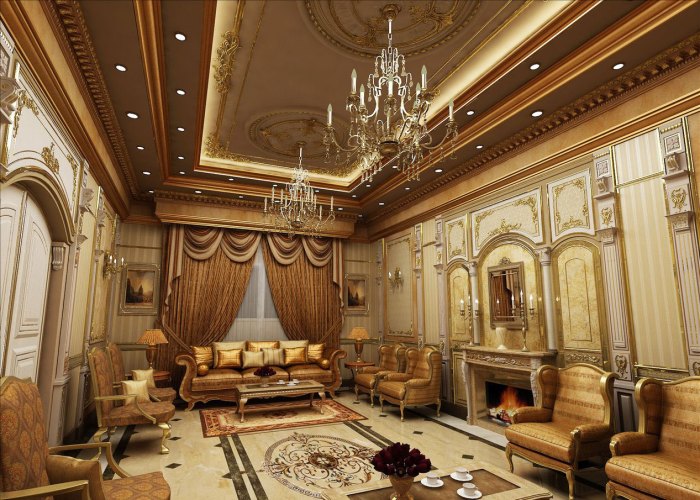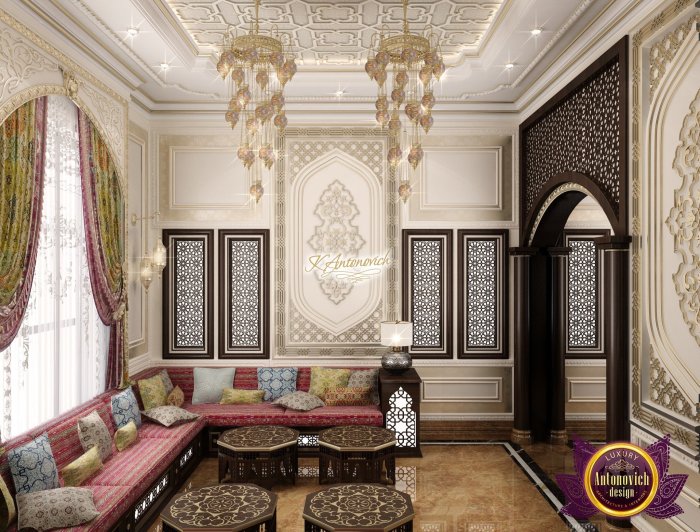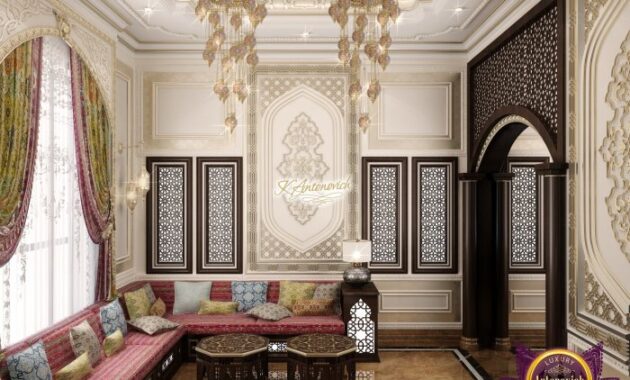Arabic house interior design transcends mere aesthetics, offering a captivating glimpse into a rich cultural heritage. It’s a world where intricate patterns, vibrant colors, and luxurious materials converge to create spaces that are both visually stunning and deeply meaningful. From the grand arches of ancient palaces to the cozy courtyards of traditional homes, Arabic design embodies a timeless elegance that resonates with both history and modernity.
This exploration delves into the heart of Arabic interior design, unveiling the historical influences, key principles, and modern interpretations that shape this unique style. We’ll uncover the significance of color, materials, furniture, and lighting, discovering how these elements weave together to create a sense of warmth, hospitality, and cultural identity.
Color Palette and Material Selection

Color plays a significant role in Arabic culture, often symbolizing different aspects of life and reflecting the region’s rich history and traditions. This cultural significance translates into interior design, where colors are carefully chosen to create a specific atmosphere and evoke desired emotions.
Arabic house interior design often features intricate details, rich colors, and a focus on comfort and hospitality. When working with smaller spaces, like a 45 square meter house interior design , you can still incorporate these elements by using clever layout strategies and incorporating multi-functional furniture.
Even in a compact space, Arabic design principles can create a welcoming and luxurious atmosphere.
Color Palette in Arabic Homes
Color palettes in Arabic homes are often inspired by the natural surroundings, incorporating earthy tones, vibrant hues, and metallic accents.
Arabic house interior design often features intricate details, rich colors, and a focus on creating a welcoming and comfortable space. When considering a two-story home, you can incorporate these elements in a modern way. For inspiration, you can check out 2 storey house design interior examples that showcase how traditional Arabic design principles can be adapted to contemporary living.
These designs can help you create a unique and inviting space that reflects your personal style while incorporating the essence of Arabic architecture.
- Traditional Color Palettes:Traditional Arabic homes often feature a warm and inviting color scheme, incorporating earthy tones like beige, terracotta, and ochre. These colors are often paired with vibrant accents of blue, green, and gold, inspired by the desert landscape, lush oases, and precious metals.
For example, a traditional Moroccan home might feature a terracotta-colored floor, beige walls, and blue and green tile accents.
- Modern Color Palettes:Modern Arabic homes often embrace a more contemporary approach to color, incorporating bolder and more vibrant hues. While earthy tones are still prevalent, modern homes often feature brighter colors like turquoise, coral, and emerald green, reflecting a more dynamic and cosmopolitan aesthetic.
These colors are often used in accent walls, furniture, and decorative elements, adding a touch of vibrancy to the space.
Material Selection in Arabic Interiors, Arabic house interior design
Arabic interiors often feature a blend of traditional and modern materials, reflecting the region’s rich cultural heritage and contemporary design trends.
- Wood:Wood is a staple material in Arabic interiors, often used for furniture, doors, and ceilings. Cedar, walnut, and oak are popular choices, known for their durability, beauty, and warm tones. Intricate wood carvings are often incorporated into furniture and architectural elements, adding a touch of artistry and craftsmanship.
Arabic house interior design often features intricate details, vibrant colors, and a focus on comfort and hospitality. The use of traditional materials like wood, stone, and textiles creates a warm and inviting atmosphere. A strong connection to the 1960s house interior design can be seen in the use of geometric patterns and bold colors , which also find their way into contemporary Arabic interior design.
This blend of tradition and modern influences creates a unique and captivating aesthetic that reflects the rich cultural heritage of the Arab world.
- Stone:Stone is another common material used in Arabic interiors, particularly for floors, walls, and decorative elements. Marble, limestone, and sandstone are popular choices, known for their durability, elegance, and natural beauty. Stonework often features intricate patterns and mosaics, adding a touch of artistry and cultural significance.
- Textiles:Textiles play a significant role in Arabic interiors, often used for upholstery, curtains, rugs, and decorative elements. Silk, velvet, and cotton are popular choices, known for their luxurious feel, vibrant colors, and intricate patterns. Traditional textiles, such as kilim rugs and embroidered cushions, are often incorporated into modern interiors, adding a touch of heritage and authenticity.
- Metal:Metal is often used in Arabic interiors for decorative accents, lighting fixtures, and furniture. Brass, copper, and silver are popular choices, known for their warm tones, reflective qualities, and historical significance. Metalwork often features intricate patterns and designs, adding a touch of artistry and sophistication.
Last Recap: Arabic House Interior Design

As we conclude our journey into the captivating world of Arabic house interior design, we are left with a profound appreciation for its enduring beauty and cultural significance. From the intricate details of traditional motifs to the bold expressions of contemporary trends, Arabic design continues to inspire and enchant.
Whether seeking inspiration for your own home or simply wanting to deepen your understanding of this rich cultural tradition, exploring Arabic interior design is a rewarding experience that offers a glimpse into the heart of a fascinating world.
FAQ Corner
What are some common colors used in Arabic interior design?
Arabic design often features rich, warm colors like gold, turquoise, crimson, and deep blues. These colors evoke a sense of luxury, tradition, and hospitality.
How does lighting play a role in Arabic interior design?
Natural light is highly valued in Arabic architecture, often incorporated through courtyards and intricate window designs. Decorative lighting fixtures, such as lanterns and chandeliers, add ambiance and create a warm, inviting atmosphere.
What are some popular architectural elements in Arabic homes?
Arches, domes, intricate patterns, and the use of traditional materials like wood and stone are common architectural features in Arabic homes. These elements contribute to the unique character and aesthetic appeal of Arabic design.

